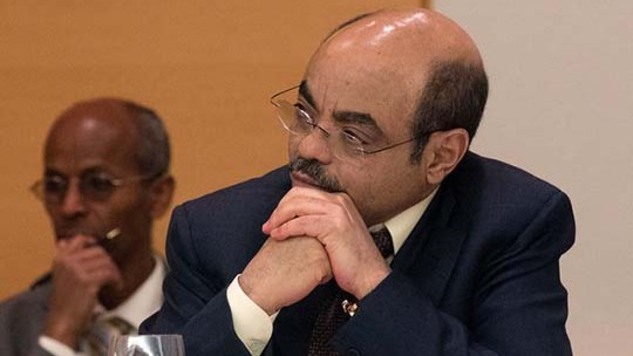15
May
A HORSE-drawn carriage festooned with balloons and Ethiopian flags stops in front of a crowd at a ramshackle football stadium.
Two women in traditional white dresses pluck a gold trophy from the cart and place it on a stage inside a garland of red and white roses. Beneath is a computer-generated image of the $3.8 billion dam Ethiopia is building across the main tributary of the Nile River.
The trophy celebrating what will be the world’s seventh- biggest hydropower plant, the Grand Ethiopian Renaissance Dam, has arrived at Debre Birhan town.
It’s the latest stop in the African nation of almost 100 million people in an Olympic torch-style promotional tour.
The rally featuring circus performers in Ethiopia’s red, yellow and green colours is part of a four-year drive to raise funds for the GERD project that Prime Minister Meles Zenawi, who died in 2012, said Ethiopia had to pay for on its own.
An engraving on the trophy’s base dedicates it to the dam’s owners, the Ethiopian people. Public events maintain momentum for a unifying project that offers hope, said Zadig Abraha, deputy head of the dam’s fund-raising council, on May 5
“We have starved and experienced famine for so long while having this immense resource,” he said about the Blue Nile. “When the government decided to build the dam the people have enormously welcomed it as they know they will benefit.”
In tents outside the festivities 130 kilometers (81 miles) northeast of the capital, Addis Ababa, dam bonds denominated as low as 25 Ethiopian birr ($1.22) are sold.
Mobile lottery
Assefa Yeshitla, a farmer at the pageant, bought a 500-birr bond with an interest rate below inflation. “I really want to contribute with what I have,” he said.
A text-message lottery featuring prizes of cars and houses is regularly held to help pay for works scheduled for completion in 2017.
Ethiopia’s government says the project will end poverty and make it a regional electricity hub. GERD is designed to produce 6,000 megawatts, almost triple the country’s current generating capacity.
Downstream, Egypt worries the dam may leave its citizens short of the water they get from the Nile for crops and industry. Analysts including Harry Verhoeven, a professor of government at Georgetown University in Washington, caution a lot needs to be done before the benefits of the dam are realised.
At the pageant, cardboard placards scrawled with slogans handed out to school kids, farmers and civil servants proclaim a determination to harness the river that begins in Ethiopia’s highlands. Seven weeks before parliamentary elections, the ruling coalition’s worker-bee logo is prominent. Concerts, sports days and a bond-buying week in April mark the project’s fourth anniversary.
Financing blocked
“Meles, we will fulfill your word,” says a sign that Assefa, wearing a green wooly hat, is holding. “The Nile dam will become reality with the help of our people.”
Meles, a former rebel leader who took power in 1991, announced the GERD plan near the Sudan border in 2011, saying foreign financing for Blue Nile projects had been blocked by Egypt. The location was first identified in 1964 during the rule of Ethiopia’s last emperor, Haile Selassie, after Egypt and Sudan signed a treaty in 1959 dividing Nile waters between them.
Cairo’s government has said it’s concerned about losing control of the world’s longest river to Ethiopia and receiving less water during the filling of a reservoir whose capacity is more than 1.5 times the Blue Nile’s annual flow. The spat reflects centuries of mistrust over the waterway, though that may be changing.
Regional cooperation
In March, the countries, along with the other downstream nation, Sudan, agreed in principle to cooperate on the GERD and said that Sudan and Egypt will be first in line to buy its electricity.
“We have collectively decided to turn this project from a potential regional conflict project into a regional cooperation project,” Mohamed A.F. Ghoneim, Egypt’s deputy ambassador to Ethiopia, told reporters in Addis Ababa on Tuesday. “When this electricity is being generated, Ethiopia needs to sell it, Egypt needs to buy it.”
When studies on the GERD’s impact are completed in about a year, the countries will try and agree on implementing the conclusions. Meanwhile, Ethiopia forges ahead with its most ambitious project to date.
The mobilisation has raised 7.1 billion birr from the public out of an expenditure of 40.4 billion birr so far on a project almost half-finished.
Surging economy
The confidence to self-fund the biggest dam possible in Ethiopia stems from a surging economy. Ethiopia grew quicker than any other African nation, an average of 10.9%, over the past decade, International Monetary Fund data show.
The lender warned in October that infrastructure investments led by GERD risk “further crowding out” lending to private companies in Ethiopia.
For the dam to pay off, the three nations have to take concrete steps toward cooperation, especially as power-hungry Egypt will be a key buyer of its electricity, said Verhoeven.
Ethiopia wants to export 1,200 megawatts to Sudan and 2,000 megawatts to Egypt along two high-voltage transmission lines. Exporting all of GERD’s power could earn about $1 billion a year, according to a group of scientists convened by the Massachusetts Institute of Technology.
One of the most critical issues is to have the links built and contracts signed as soon as possible, said Marc Jeuland, an assistant professor at Duke University’s Global Health Institute in Durham, North Carolina, who has studied the Blue Nile basin.
“If this project gets built and there are no deals, Ethiopia could get stuck getting a really low rate for power and not being able to pay off this large capital investment,” he said.
For the Ethiopians mobilised in Debre Birhan, the concerns are less about electricity flows and more about ensuring the river doesn’t continue to slip away from them.
“What did the brave person say?” chant a group of young men. “I will not give the Nile to other people.”
Source: http://mgafrica.com/article/2015-05-14-ethiopian-sells-38bn-nile-mega-dam-like-it-were-the-olympics-and-the-masses-are-buying-up
